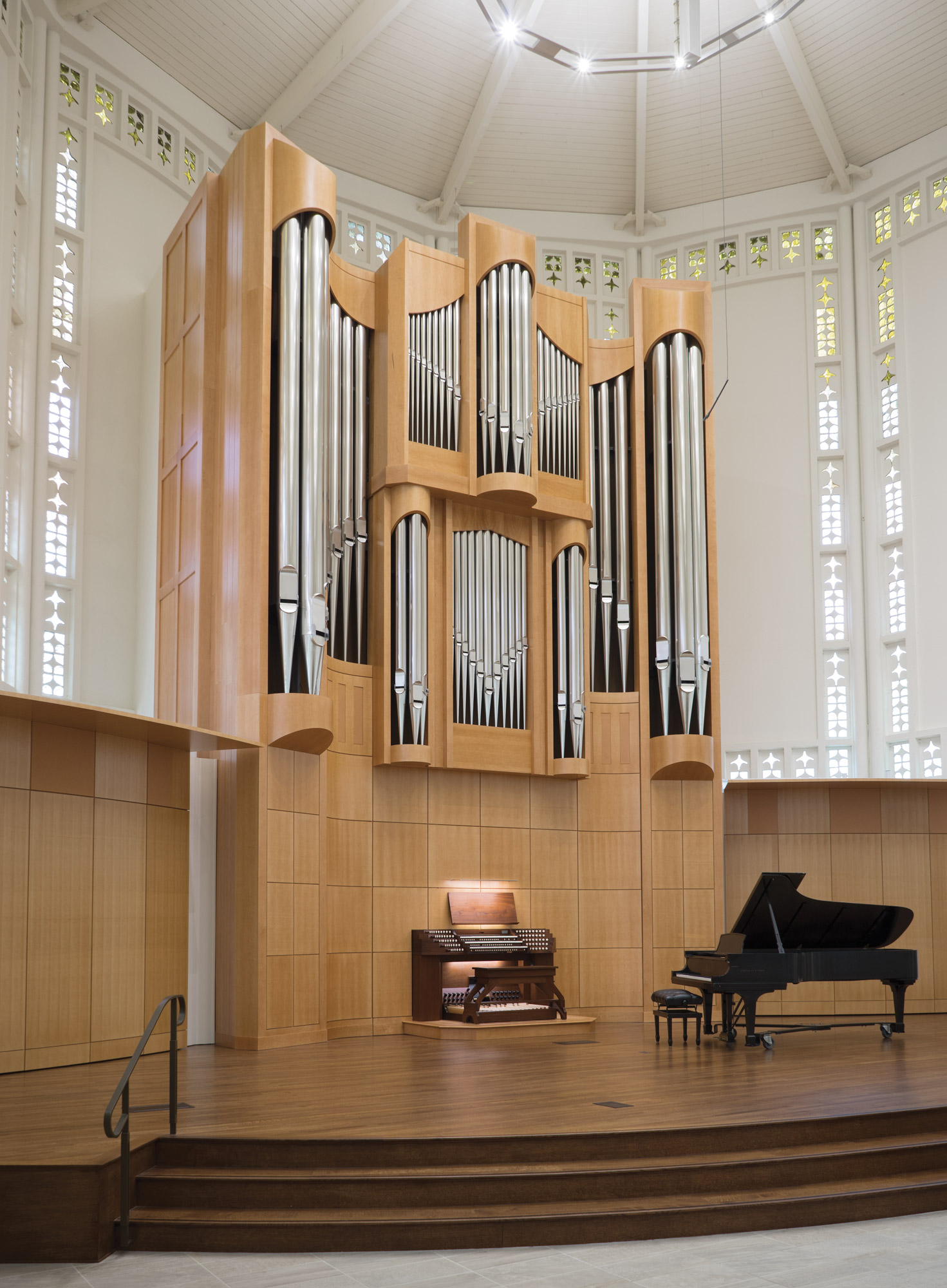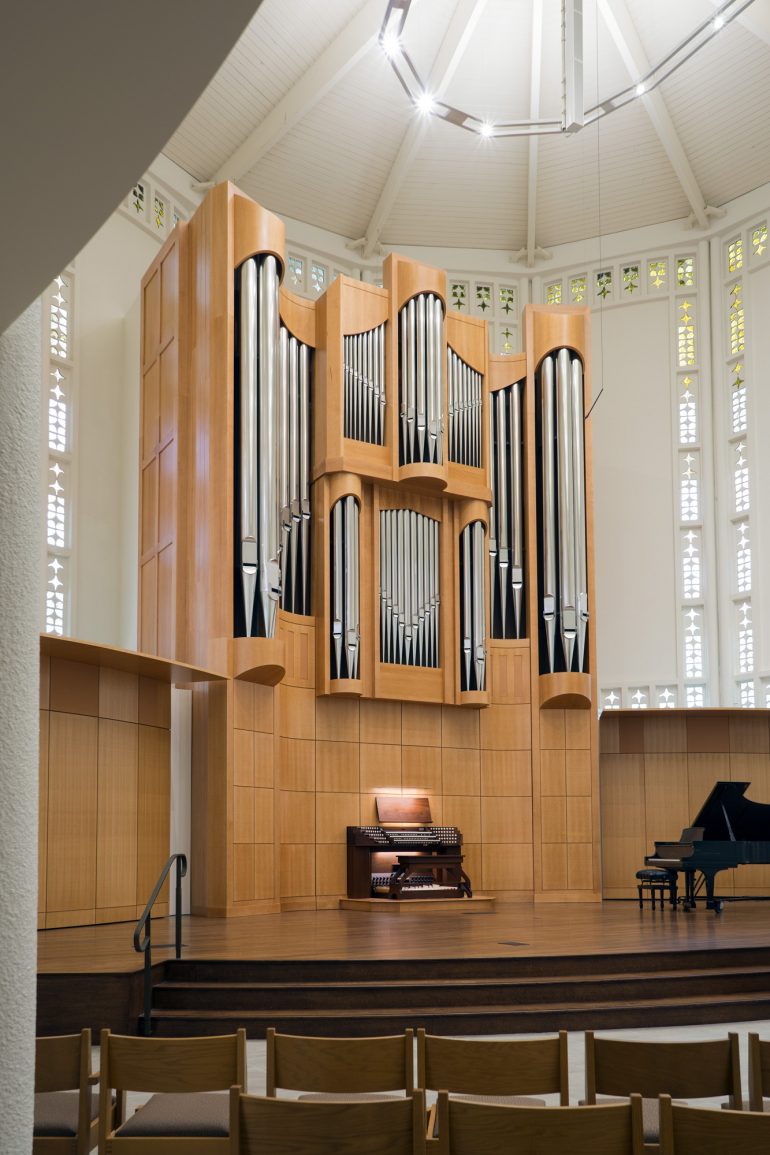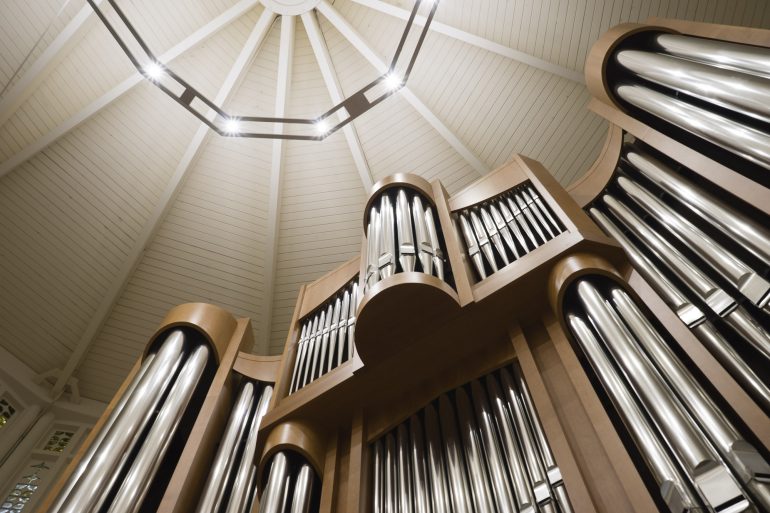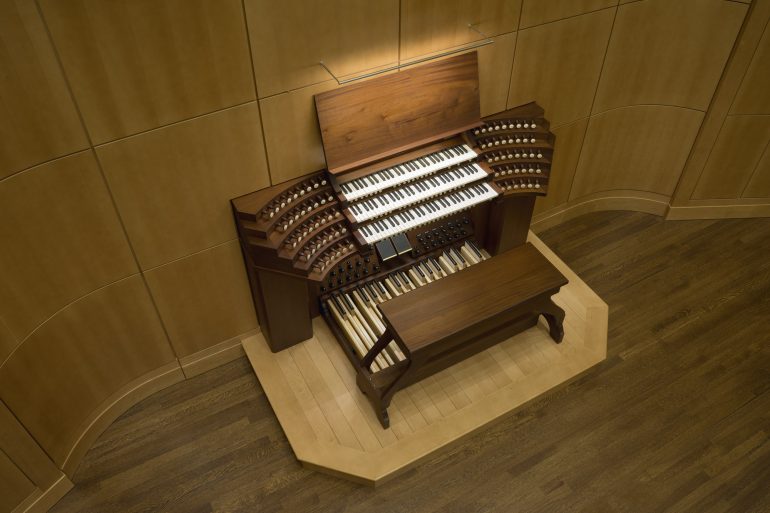
- phone: 978.283.1909
- email: cbfisk@cbfisk.com
Opus 140
Plymouth Church
Seattle, WA
Stops: 55
Independent Voices: 46
Pipes: 3398
Created: 2015
Seattle’s oldest Protestant congregation, Plymouth Church has resided in the heart of Seattle since 1869. Plymouth plays an important role in the city’s civic and spiritual history and is well known for its social justice programs and community outreach. The current church building, the fourth in Plymouth’s history, was dedicated in 1967 and was designed by Naramore Bain Brady & Johanson, a global architecture firm founded in Seattle in 1943. The white, concrete and glass, oval-shaped building is a distinctive part of Seattle’s modern architectural landscape.
In 2014, the sanctuary underwent a major renovation under the guidance of LMN Architects of Seattle, including acoustical improvements making it a very favorable environment for organ music. Plymouth’s new organ, Opus 140, is placed front and center in the lofty sanctuary. Fisk visual designer Charles Nazarian created an organ case design honoring the modernist architecture of the building, but also subtly incorporating elements of historical French organ design. The case is built of solid maple and features the burnished tin Grand Orgue Montre 16′ in its façade.
The organ is resolutely French Romantic, strongly favoring the best work of 19th-century organbuilder Aristide Cavaille-Coll. It also includes certain voices of the French Classical style in order to expand its ability to lead congregational singing, to accompany the church’s excellent choir, and to perform solo organ repertoire. The specification is the result of discussions with world-renowned organist Douglas Cleveland and comprises 3 manuals and pedal, 55 stops, 45 independent voices, and two divisions under expression. The instrument was delivered to the church in March 2015 and the dedication concert, played by Mr. Cleveland, occurred on November 15, 2015.

Grand Orgue, Manual I
Montre 16′ en façade
Montre 8′ en façade
Gambe 8′
Flûte harmonique 8′
Bourdon 8′
Prestant 4′
Flûte ouverte 4′
Doublette 2′
Plein jeu harmonique II-VI
Plein jeu VI
Cornet V (A # 0 -f 3 )
Bombarde 16′
Trompette 8′
Clairon 4′
Positif expressif, Man II, enc
Bourdon 16′
Principal 8′
Salicional 8′
Unda maris 8′ (t.c.)
Bourdon 8′
Prestant 4′
Flûte douce 4′
Nasard 2 2/3′
Doublette 2′
Tierce 1 3/5′
Plein jeu V
Trompette 8′
Cor anglais 8′
Clarinette 8′
Récit expressif, Man III, enc
Quintaton 16′
Viole de gambe 8′
Voix céleste 8′
Flûte traversière 8′
Cor de Nuit 8′
Dulciane 4′
Flûte octaviante 4′
Quinte 2 2/3′
Octavin 2′
Carillon I-III
Basson 16′
Trompette 8′
Basson-Hautbois 8′
Voix humaine 8′
Clairon 4′
Pédale
Principal 32′ ext Gt.
Contrebasse 16′
Montre 16′ from Gt.
Soubasse 16′
Flûte 8′ ext.
Gambe 8′ from Gt.
Bourdon 8′ ext.
Flûte 4′ ext.
Contre Bombarde 32′ ext.
Bombarde 16′ from Gt.
Basson 16′
Trompette 8′
Couplers:
Positif to Grand Orgue
Récit to Grand Orgue
Récit to Positif
Octaves graves Grand Orgue
Grand Orgue to Pédale
Positif to Pédale
Récit to Pédale
Accessories:
Trémolo Grand Orgue and Positif
Trémolo Récit
Trémolo rapide Récit
Vent flexible
Clochettes
Key Action: Direct mechanical (tracker) except for large bass pipes.
Kowalyshyn Servopneumatic Lever: This provides a pneumatic assist to the Grand Orgue key action and anything coupled to the Grand Orgue. It also allows the addition of the “Octaves graves” coupler to the organ, which couples the Grand Orgue to itself at sub-octaves and any division coupled to it also appears on the Grand Orgue at sub-octaves.
Stop Action: Electric solenoid.
Combination action by Solid State Organ Systems.
Key Desk: Built into main case of organ, 3 manuals and pedals, Manuals 61 notes CC – c 4 , cowbone naturals, sharps of ebony.
Pedals 32 notes CC – g 1 .




